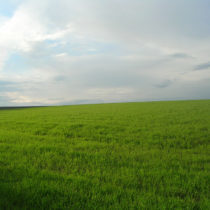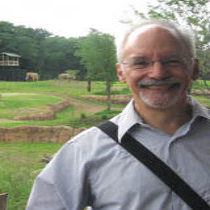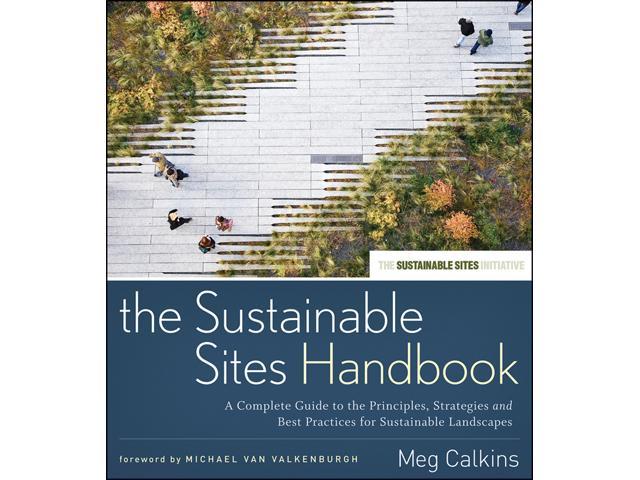Landscape Architecture for Landscape Architects › Forums › SUSTAINABILITY & DESIGN › What’s wrong with this picture?
- This topic has 1 reply, 7 voices, and was last updated 13 years, 7 months ago by
 Tosh K.
Tosh K.
-
AuthorPosts
-
May 8, 2012 at 5:17 pm #157558
 Jason T. RadiceParticipant
Jason T. RadiceParticipantWhat is wrong with this picture? (answer below)
I got an e-mail regarding the release of this book from Wiley. It looks like a pretty good book and will check it out when I find a copy somewhere (I never judge a book by its cover, but I actually want to see the thing before I buy it).
But the cover disturbed me. Talk about delicious irony…more delicious even than a 5 Guys Bacon Cheeseburger All the Way (with extra bacon). This book is about sustainable sites, is it not? But the cover photo is that of Corner’s High Line in NYC, one of the LEAST sustainable landscapes you can design! Despite its natural appearance, the High Line is a giant linear intensive green roof, and intensive green roofs require great amounts of maintenance, irrigation, and nutritional supplementation. What’s more, in order to keep the design intent, this park is not going to be allowed succession, rather, it is pruned and weeded for volunteers (by volunteers…and paid staff). Not that there is anything wrong with any of that…it just does not really meet the term “sustainable”. A very famous LA (I’m not going to namedrop) once told me you walk a real tightrope with that term to begin with, as it has various degrees of meaning and is terrifically vague. I think this might be proof.
I don’t blame the authors, knowing what I do about publishing, the likely had little input on the choice of cover for the book. That is generally the publisher’s art-department’s call. In this case, an interesting image to hitch on to the popularity of the High Line.
May 8, 2012 at 6:57 pm #157571 Tosh KParticipant
Tosh KParticipantIt’s a close call as to the number of weeders I’ve seen up there as compared to the gardens in Kyoto. Perhaps part of bringing back “nature” into the city is to show how much maintenance certain aesthetics requires?
Also curious is the forward – at least his design for the HL had succession as an integral part, which I understood to be what was ever so charming about the now rebuilt rail tracks.
May 9, 2012 at 3:02 pm #157570 allandParticipant
allandParticipantTrue. Some “general public” type people have mentioned this project to me. I guess that means it has at least broken through as a landscape architectural project. I guess that helps…or does it?
May 9, 2012 at 4:55 pm #157569 Trace OneParticipant
Trace OneParticipantAlland, you have to get tickets to visit the High Line in New YOrk, practically. It is hugely crowded, almost from it’s first day.
and that is a really good call, Jason. I hate the feathered look anyway, you have given me another reason to dislike it..
May 10, 2012 at 8:42 am #157568 idaParticipant
idaParticipantSo what project would you rather see on the cover?
May 10, 2012 at 9:58 pm #157567 Jason T. RadiceParticipant
Jason T. RadiceParticipantHow about any one of the SSI pilot projects, which would actually represent the content of the book? Three have been certified so far.
May 11, 2012 at 1:50 am #157566 idaParticipant
idaParticipantIt might have been a marketing choice to choose the Highline as the cover to grab more attention. Sure there are a lot more sustainable projects, but what recent landscape project other than the Highline has garnered media attention and is so well known to the public?
I think if people are willing to put the time and resources to maintain a landscape, then couldn’t you consider that sustainable? If funding suddenly stops to maintain the Highline then it would end up becoming what it used to be (and what JCFO tried to preserve with their design), a wild elevated piece of “found” nature. I don’t think the project is all that bad in regards to sustainability. I think a golf course that is rarely occupied is far worse. At least with the Highline it is a park that a lot of people use and value on a daily basis.
May 14, 2012 at 11:58 am #157565 Rob HalpernParticipant
Rob HalpernParticipantWhich (once again) calls into question the buzz-word concept “sustainability.” What can an unsustainable species do that can in any way be “sustainable”?
May 14, 2012 at 3:58 pm #157564 Jason T. RadiceParticipant
Jason T. RadiceParticipantThis is not a book that you will find at Barnes and Noble that the average consumer (public you speak of) will even attempt to look at. This is an industry-specific publication. Using a ‘flashy’ well known project for the cover is entirely irrelevant to book sales. In fact, there could have been NO cover image at all.
It is not so much the time and effort to maintain the garden that kind of rules out sustainability, though it is less self-sustaining than other choices. But in this case, those persons are performing great amounts of work and unnatural selection to keep plants that would not naturaly survive there growing. As well, the plants rely on an artificial growing environment including lightweight growing medium, which will require nutrient supplementation to keep the plants that were chosen growing properly, and massive amounts of irrigation. That really does not equal “sustainable.” If left without these inputs, most of it would die. To me, the high line does not even resemble what was there before this project. That was the best kind of sustainable…self sustaining…as no human input of any kind was required.
May 15, 2012 at 2:23 am #157563 idaParticipant
idaParticipantDo you know of any study that looks into the sustainability of The Highline? I’d be interested to read any study that refutes Friends of The Highline’s claim that the project is sustainable. My understanding of the designers’ intent was to design for the micro-climate of the site with drought-tolerant, locally grown native plants, and that the maintenance plan calls for sustainable practices.
May 15, 2012 at 2:45 am #157562 Jason T. RadiceParticipant
Jason T. RadiceParticipantAll you have to do is go there and see it yourself, and look beyond the plants into the planitng structure and environment. I also saw them building the second section and know whats underneath the lush plantings.There are lots of irrigation lines running in the growing media. The “friends” can claim whatever they want, but just because they say it is, does not mean it is. The word itself has lost its meaning to become a generic buzz-word, which is why one must very careful using it.
Info from the HighLine wensite itself. Only 50% of the plants are native to North America, and 30% to the Northeast. Which is to be expected in such a harsh climate. Right plant, right place. I have no problem with that. It is also artificially fertilized with a brewed organic fertilizer, but it does receive artificial nutrients. No problem there either. And it is indeed irrigated. Again, no problems. But it is a totally artificial landscape, and left on its own, would die off and be succeeded by the types of plants that were removed in the first place VERY quickly. Therefore, it is not truely sustainable, and to call it so is misleading, at the very least.
May 15, 2012 at 9:53 am #157561 idaParticipant
idaParticipantI don’t trust my own eyes or knowledge, so I will wait for an in depth study. It’s interesting that you point to these issues as it is difficult to look beneath what is being said, I’m kind of in the middle now in terms of The Highline’s sustainability. However I still love it and it’s been a while since a landscape project has received so much public excitement.
I wonder what the SITES book has to say about The Highline.
May 15, 2012 at 1:21 pm #157560 Trace OneParticipant
Trace OneParticipantAilanthus, artemesia, black cherries, pokeweed, jimson weed – how’s that for a sustainable plant palette for the High Line? And anything that falls in, like perhaps a walnut, can grow up where it has some support from the local weeds…
How about that, Jason? How would you make the High Line sustainable, if Jim Corner called you up and asked you to redesign it for a few hundred thousand, just the design, no GC work..
full of dreams today, both waking and sleeping, nightmares and – the opposite..
hee hee!
May 15, 2012 at 2:49 pm #157559 Wyatt Thompson, PLAParticipant
Wyatt Thompson, PLAParticipantI have the Sustainable Sites Handbook at my desk right now. It says nothing about the Highline because it’s not a Sustainable Sites project. That’s the point. The book is not about “sustainability.” It’s about a very specific metric by which sites can be judged to be sustainable based on the SSI definitions. It’s possible that the Highline is very sustainable, and it’s even possible that it could meet several of the criteria outlined in the book. The problem is that it’s not a certified Sustainable Site, nor has it ever billed itself to be. I agree with Jason that it’s not an appropriate image for this book.
-
AuthorPosts
- You must be logged in to reply to this topic.



